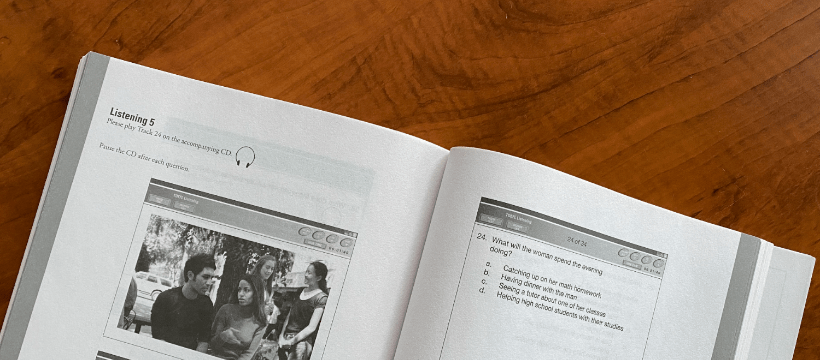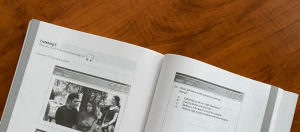【新形式】TOEFLリスニングの問題形式と対策法についてご紹介します。
【新形式】TOEFL リスニングの概要
新形式TOEFL リスニングセクションの概要を確認しておきましょう。
まず試験時間は36分、設問数は28問となります。
- 会話と講義の2種類が出題される
- 3-7分の会話や講義
- 会話については、1つの会話につき設問は5つ
- 講義については、1つの講義につき設問は6つ
<主な出題パターン例>
| 会話 | 講義 | 講義 | 会話 | 講義 |
| 5問 | 6問 | 6問 | 5問 | 6問 |
| 会話 | 講義 | 会話 | 会話 | 講義 |
| 5問 | 6問 | 5問 | 6問 | 6問 |
採点方法・採点基準
1問正解するごとに1ポイント可算されます。素点と言われます。
獲得ポイントの合計が、30点満点のスコアスケールに換算されてスコアが決まります。
換算方法はその時の難易度や受験者数なども関わるため試験毎に違うと言われています。
【新形式】TOEFLリスニング 問題形式
それでは、TOEFLリスニングの設問タイプを確認していきましょう。
設問を先に見ることはできませんが設問形式はいつも一緒なので、「どこに注目するべきか」、「何をノートティキングすべきか」の指針となります。
選択問題は形式が7つありますので聞かれるポイントを把握しましょう。
1. multiple-choice (選択問題)
4択の選択肢から、設問に最も適当な選択肢を選びます。大体6つの形式に分けられます。
選択肢の中には、部分的にあっているものもありますが、その設問の目的に最もふさわしいものを選ばなければいけません。
- Question: What is the main topic of discussion? (main idea)
→ テーマを問う問題
<問題例>
Which is the main topic of the lecture?
A. The range of developmental disorders that future teachers should be aware of
B. The varied ways in which Sensory Processing Disorder presents itself
C. The cures for Sensory Processing Disorder
D. How to teach students who are interested in education and children
- Question: Which of the following most accurately defines a carnivorous plant? (details)
→ (,メインアイディアにつながる)詳細に関する問題
<問題例>
Which is the main topic of the lecture?
A. The range of developmental disorders that future teachers should be aware of
B. The varied ways in which Sensory Processing Disorder presents itself
C. The cures for Sensory Processing Disorder
D. How to teach students who are interested in education and children
- Question: Why does the student go to see the professor? (purpose)
→ 発言の意図・目的を問う問題
<問題例>
Why does the professor mention that coral reefs support more than 4,000 species of fish?
A. To find out what students know about tropical fish
B. To contrast two types of ocean environments
C. To imply that there may be species in the Southern Ocean that have not been discovered yet
D. To imply that there may be fossil evidence of coral reefs in the Southern Ocean.
- Question: How is the lecture organized? (organization)
→ 話の展開を問う問題
<問題例>
How does the professor organize his lecture on blue jeans?
- In a sequence to explain the various methods of producing this faded and worn look of jeans
- Through introducing an abstract category like the idea of stone-washing to a specific example of how this is done
- By creating a question and answer format to involve the students in the topic of blue jeans
- With explaining the development of different kinds of pants and their impact on the popularity of blue jeans today
- Question: What does the professor imply about geysers? (imply)
→ 段落から推論する問題
<問題例>
What does the professor imply about the experience of mimicking the migration of the zooplankton?
- The tides of a large body of water like an ocean certainly impact the migration of the zooplankton
- It was difficult to see any movement created by the organisms in the tank, and therefore it is assumed that there would be little movement created in an ocean by similar organisms
- If eddies formed in a small tank with a much smaller number of organisms, then it is highly likely that the same would be true in an ocean with billions of organisms.
- There is not much validity about the experiment conducted in the lab so the results are flawed.
- Question: What is the Professor’s attitude? (attitude)
→ 話し手のAttitudeやfeelingsが問われる問題
<問題例>
What is the student’s attitude toward the Jazz group?
- She fears they haven’t practiced enough
- She feels they might have deceived her
- She wants them to work together on a project
- She likes how they resolved their acoustical and sound issue
- Question: Fill in a table or chart (connecting content)
→ リスニングの情報展開を整理することが求められる問題
<問題例>
Indicate whether each of the following activities describes a displacement activity by checking “yes” or “no”.
| Activity | Yes | No |
|---|---|---|
| Instead of attacking the enemy, an animal attacks another object. | ||
| During its mating ritual, an animal suddenly leaves or flies away | ||
| When a predator confronts it, an animal falls asleep instead of eating its food | ||
| After preening itself, an animal drinks water. |
2. 並び替え問題
与えられた選択肢を並べ替える問題です。
一連の出来事や、プロセスの各段階などについて、正しい順序で並べます。
複数の選択肢を、時系列に沿って並び替えなくてはいけません。
<例題>
Write your answer choices in the spaces where they belong. You can either write the letter of your answer choice or you can copy the sentence. the first one is done for you.
| 1. THe government provided no official support for the arts. |
| 2. |
| 3. |
| 4. |
| 5. |
🄰 Arts councils were established in all 50 states of the country.
🄱 The federal budget supporting the arts was reduced by half.
🄲 The federal Art Project helped reduce unemployment.
🄳 The National Endowment for the Arts was established.
3. 表完成問題 (Yes or No Answer 問題)
この問題形式では、表の各項目を分類したり、正誤を判断したりする問題が出題されます。リスニングの内容が合っているか間違っているかを表で答える。
Question: Indicate whether each of the following activities describes a displacement activity by checking “yes” or “no”.
| Activity | Yes | No |
| Instead of attacking the emery, an animal attacks another object | ||
| During its mating ritual, an animal suddenly leaves or flies away | ||
| When a predator confronts it, an animal falls asleep instead of eating its food | ||
| After preening itself, an animal drinks water |
【新形式】TOEFL リスニング注意点と対策法
- 1度答えを選んだら変更することはできません。
- 前の問題に戻ることはできません。
- 場面説明をよく聞きましょう。聞き逃さないように注意。
- ノートは必ず取る。
音声が長いので、忘れないようメモを取りましょう。 - 出来るだけ多くの情報をメモに書き取るようにしましょう。
- 1つの質問に対して、解答には最大約30秒使うことができます。
- 音声を2回聞くことはできません。
ただし、もういちど音声を聞いて解く問題もあります。
まとめ
TOEFLのリスニング対策では、音声は一度だけで、設問は先に見ることはできません。
設問形式は覚えておくとメモのポイントが理解できるので無駄に書き取る必要がなくなります。
ほとんどの場合、概要を聞く選択問題ですので、リスニングの大体の内容を理解することができればある程度の点数が取れるでしょう。
高得点を目指す方は詳細問題で点数を取ることがポイントですのでリスニング力を鍛えましょう。
日頃から音声を聞いたときに重要な内容をメモできるかどうかがカギとなります。日頃から長めの英語の音声を聞いて、メモを取る練習をしておきましょう。
リスニング力も鍛える



